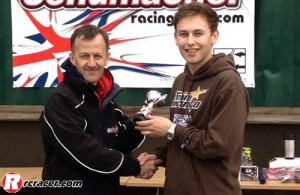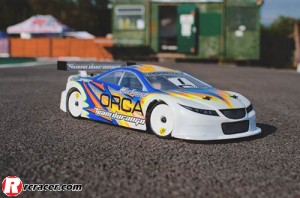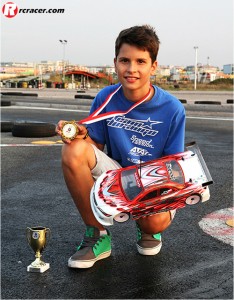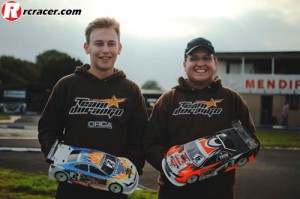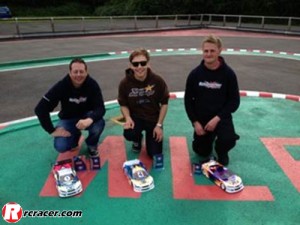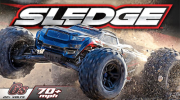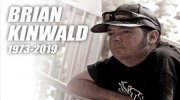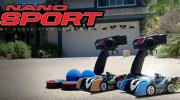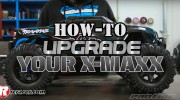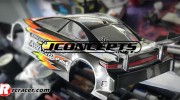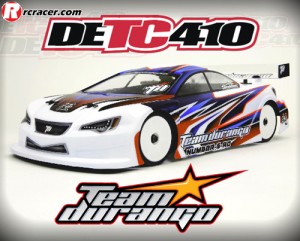 Adam Skelding is the chief designer of the DETC410. With the upcoming global arrival of the DETC410 very soon, Team Durango thought it would be the perfect time to share some DETC410 facts from Adam Skelding. He explains the design theory behind Team Durango’s first touring car platform, and gives you a deeper insight into how the DETC410 will make you faster, straight from the kit box:
Adam Skelding is the chief designer of the DETC410. With the upcoming global arrival of the DETC410 very soon, Team Durango thought it would be the perfect time to share some DETC410 facts from Adam Skelding. He explains the design theory behind Team Durango’s first touring car platform, and gives you a deeper insight into how the DETC410 will make you faster, straight from the kit box:
Team Durango: How long did you work on the DETC410 concept prior to beginning to design the car?
Adam Skelding: As we were starting with a blank sheet of paper (we had no car in this class), we needed to take some time to look at the cars that were popular and fast in the class. We probably started a good two to three months before we actually started putting ideas down on paper for what we would like from the car, and any critical design features.
TD: What were the core design philosophies that you wanted to apply to the DETC410?
AS: We wanted to make the most tuneable car we could straight out of the box. The touring car class has its own sub set of classes – modified, 10.5T,13.5T, 17.5T, 21.5T and then you can run with boost or blinky classes. These sub sets all require the car to be tuneable in different ways as there is a different driving style from say mod to 17.5T blinky. We needed our car to be able to cover this. Then you have asphalt and carpet racing, the permutations and combinations are now starting to build up, so you can see that the car needed to have a wide sweet spot that you can tune specifically to your chosen class of racing.
TD: Explain how EFRA European podium placed Elliott Harper has helped develop the project so far?
AS: Whilst we have a vast amount of RC experience at TD, we didn’t have a ‘current’ TC driver who could be the spearhead of the racing team. Elliott was brought on board as he is an on-road racer through and through and has been at the top of the European and World Championships the last few years. His experience of where the class is going and what makes a good car from a bad car was key in helping us make the right design choices when there were multiple options to choose from.
TD: What is your favourite design element of the DETC410 and why?
AS: Probably the amount of tuning we crammed into the box. It’s not a single design element, but the ethos we aimed for was carried out really well.
TD: Do you race touring cars yourself?
AS: I have raced touring cars before, but this was some years ago before LiPo and brushless became the norm for electric RC. I’ve now picked up the sticks again in TC and I take my DETC410 to local club meetings to showcase how easy the car is to drive (even for an off-road hack like me!)
TD: Is there a balance between aesthetic appeal and performance when designing a brand new platform for Team Durango? Tell us how you always achieve a balance between function and form?
AS: Form follows function is the design ethos that I follow. A part needs to be designed a certain way to get correct geometry and function. This provides the basic form, once you then get a collection of parts in certain area, then you can really start looking into the form of a collection of parts. This can seem like a never ending loop as you change one part which then affects the look of other parts around it, but soon a more finished design starts to take shape.
TD: Are there any qualities from the heritage of Team Durango off-road cars that have been transferred over to the DETC410? Explain what and why?
AS: The tunablity of the car by the use of inserts is something that we brought from the DEX210 platforms. This was a first in 2WD off-road and we’ve taken it a step further with the DETC410.
TD: What makes the front DJoint driveshafts of the DETC410 special?
AS: They are just the best method of reducing chatter in the articulation angle of the DETC410 steering. Super-smooth and consistent.
TD: Explain why the DETC410 is so easy to build straight from the kit box? We have heard some racers have completed the whole kit in under four hours.
AS: Once the design was done, we spent a lot of time fine tuning the assembly process. Assembly of a TC car is not just about throwing it together, everything has to go together ‘just so’ to minimise ‘tweak’ in the car. This is a word that has been used constantly by Elliott in the feedback we get from him, ‘we need to alter this – it will help reduce tweak’. I just thought he liked Miley Cyrus! The build manual was given special attention by Ben as it’s the customers first contact with the car and we wanted the best ‘tweak-free’ build process that we could come up with that was repeatable by other less ‘tweak sensitive’ members of the office. If we can build it ‘tweak free’ then a customer will be able to build it the same way.
TD: Tuning options can be a complicated thing for newcomers to the touring car class to understand. What makes the DETC410 an easy car to set-up?
AS: In the manual we give four base set-ups for the car. These are all tried and tested by the pro drivers Elliott, Ben Cosgrove and Michal Orlowski. We’ve put them in the manual so that you can build the car to the surface your most likely to race the car on for the first time, and have the confidence that it’s going to be a good starting point and you are not going to be ‘shooting in the dark’. In fact, I built the car to the low grip carpet set-up and I didn’t change the set-up for about six meetings. It’s a really good base set-up and the car was still outperforming the driver, until I felt I was driving the car as well as I could, I saw no point in changing the set-up. I’ve now started to ‘tune’ the car and see what happens, some changes I’ve made haven’t worked, but I’ve always had the confidence to go back to default and start again.
TD: The DETC410 seems to be easy to drive for all abilities. What do you think is the biggest contributory factor to this all-inclusive outcome for the first Team Durango touring car?
AS: The time and effort put in by the whole of the team here, from driver to designer and the people in between. It has been a true collective effort, everyone has got their own bit of input to the car and could point it out.
TD: What is your most used design tool when creating a Team Durango vehicle?
AS: Solidworks
TD: How many individual parts make up a DETC410?
AS: Lots…
TD: The DETC410 seems to be incredible value for money. Racers always demand the highest specification possible for the best price. Was the DETC410 always going to be aimed at budget conscious racers who wanted a competition quality racing kit?
AS: Yes. This was one of the major design consideration as well as tuning. The suspension hangers are a good example of this one hanger is used all around the car where other manufacturers use multiple hangers. Moulded DIMEC inserts offer the adjustment, but the major cost of the machined 7075 aluminium part is kept down for the kit as there is only one style.
TD: Premium materials and race-winning geometry are now regarded as the Team Durango signature. How much testing goes into material strength prior to actually racing a Team Durango car for the first time?
AS: With the TC platform we know that the spine of the car needed to be carbon fibre and aluminium, so we had to do very little testing on this. Materials for the wishbones, hubs and drivetrain went through a number of rounds of testing before we found the best material for each application and for inclusion in the it. We of course will offer different materials for composite parts to fine-tune the car to the nth degree for different tracks, but we feel the kit has the best selection of materials to allow the car to be raced at the highest level on all tracks.
TD: Describe the DETC410 in three words?
AS: A team effort.
TD: What does the future hold for Team Durango Touring Car platforms? If you can share anything with us?
AS: Now we have a car, we’ve joined the development curve and the learning continues. Speeds will increase, lap times will lower and we need to keep our car on the pace, we can’t stand still that is for sure!
Watch the DETC410 racing to the win at the BTCC below:
Source: Team Durango






